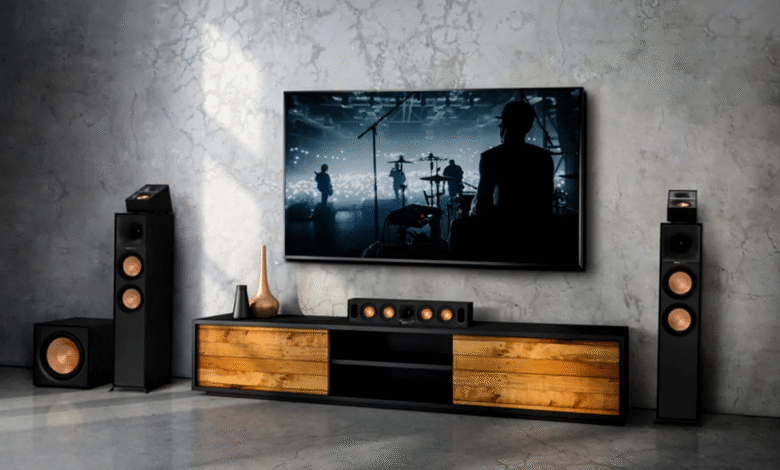How to Install and Set Up a Home Theater System

In today’s digital age, the idea of having a home theater system has become more appealing than ever. It offers the opportunity to enjoy movies, TV shows, music, and gaming in a cinematic setting, all within the comfort of your own home. Creating a home theater system involves selecting the right equipment and optimizing the audio and video experience. This guide will walk you through the process of setting up your home theater from start to finish.
Read More: 14 Smart Home Tech Trends For 2023
How to Set Up Home Theater System

Choosing the Right Location
The first critical decision in setting up your home theater system is choosing the ideal location. The choice of room and its layout can greatly impact your overall viewing and listening experience. Here are some key factors to consider:
- Room Selection: Start by selecting a room that suits your home theater needs. It should have enough space to accommodate your equipment and seating comfortably.
- Seating Arrangement: Determine the optimal seating arrangement within the room. Ensure that all viewers have a clear line of sight to the screen.
- Lighting Control: Consider how you can control lighting in the room to minimize glare on your screen. Installing blackout curtains or smart lighting can be a great solution.
Selecting Audio and Video Equipment
Once you’ve decided on the location, it’s time to select the audio and video equipment that will bring your home theater to life.
Audio Components
- Receiver: Your audio-video (AV) receiver is the central hub of your system. It’s essential to choose a high-quality receiver that can process audio and video signals effectively.
- Speakers: Your choice of speakers can significantly impact your audio quality. Select speakers that match the size and acoustics of your room. Common configurations include 5.1 or 7.1 surround sound setups.
- Subwoofer: To add depth and immersion to your audio, a subwoofer is essential for delivering those deep bass tones.
Video Components
- Display Screen: Decide whether you want a large TV or a projector screen for your home theater. Consider the size that fits your room and your viewing preferences.
- Projector: If you opt for a projector, make sure it suits your room’s dimensions and can project a clear, high-definition image.
- Blu-ray/DVD Player: Select a quality player that can provide high-definition video and audio. Consider a player that supports the latest formats for the best experience.
Wiring and Connectivity
- HDMI and Cables: Ensure you have the necessary cables for connecting your devices. High-quality HDMI cables are crucial for transmitting high-definition video and audio signals.
- Wireless Options: Explore wireless connectivity options, such as Bluetooth or Wi-Fi, to reduce cable clutter and simplify your setup.
Calibration and Setup

- Audio Calibration: After connecting your speakers and AV receiver, calibrate the audio settings to optimize sound quality. Many receivers have built-in calibration tools that can help you achieve the best audio performance.
- Video Calibration: Adjust the video settings on your screen or projector to ensure the best possible picture quality. This includes adjusting brightness, contrast, and color settings.
Furniture and Room Decor
- Seating and Acoustics: Arrange your seating to create the best possible sound and viewing experience. Consider investing in acoustic panels or curtains to enhance sound quality.
- Room Decor: Personalize your home theater with decor that complements your style. Choose comfortable seating, add wall art, and use rugs or carpeting to improve the acoustics in the room.
Conclusion
Setting up a home theater system can be a thrilling and rewarding project. With careful consideration of your room, equipment selection, and attention to detail in setup and calibration, you can create a space that delivers a true cinematic experience in your own home. Whether you’re a movie lover, gamer, or music enthusiast, a home theater system can elevate your entertainment to new heights.
Read More: Online Trading in the UK: A Guide to Financial Success
FAQs
- What’s the ideal screen size for my home theater system? The ideal screen size depends on your room’s size and the distance between the screen and your seating. Measure your room and consult with professionals if needed to determine the best screen size for your space.
- Do I need a dedicated room for a home theater system? A dedicated room is not necessary, but it can enhance the experience. You can also set up a home theater in your living room or in a multi-purpose space. The key is to optimize the room you have.
- How can I control ambient lighting in my home theater? You can control lighting by using blackout curtains, installing dimmer switches, or investing in smart lighting systems. Reducing ambient light will significantly improve your viewing experience.
- Are wireless speakers a good choice for a home theater system? Wireless speakers can provide flexibility and a cleaner look, but wired speakers are often preferred for their reliability and consistent performance. The choice depends on your preferences and the complexity of your setup.
- Is professional installation necessary for a home theater system? While professional installation can ensure the best results, many enthusiasts successfully set up their home theater systems themselves with the right guidance and equipment. Professional help is recommended if you’re unsure about any aspect of the installation or want a more complex setup.







